Despite an 11th-hour scramble due to an unexpected shift in predictions, NASA's flying observatory was in the right place at the right time on June 29th as distant Pluto briefly covered a 12th-magnitude star.
If you thought scientific data taking is a slow, boring process, you've never been on board SOFIA, the Stratospheric Observatory For Infrared Astronomy. On June 29th, SOFIA observed a stellar occultation by Pluto, and I was aboard to watch. It was the most exciting flight I've ever experienced.
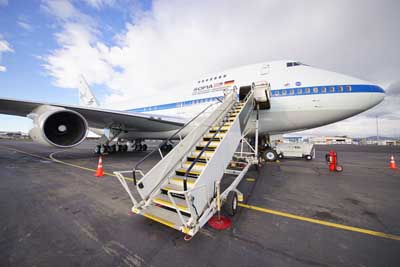
Govert Schilling
As many S&T.com readers know, SOFIA is basically an old Boeing 747-SP airliner that NASA bought and transformed into a flying infrared observatory. A German-built 2.5-meter telescope peers out into space through a large rectangular opening in the plane's fuselage. From the plane's typical cruising altitude (near 40,000 feet or 12 km), high above the clouds and most of the atmosphere's infrared-absorbing water vapor, the telescope can make unique infrared observations.
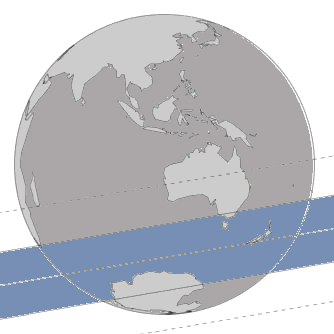
MIT Planetary Astronomy Lab
Mobility can also play a role. SOFIA's home base is Palmdale, California, but this summer, it's been deployed to Christchurch, New Zealand, to observe objects in the southern sky for six weeks. Not coincidentally, Pluto's predicted cover-up of a 12th-magnitude star in Sagittarius would be observable from a broad zone that passed over part of Antarctica, the southern Indian Ocean, southeast Australia, and New Zealand.
"It's a very special occasion," says SOFIA's chief science advisor Eric Becklin (University of California at Los Angeles), who's one of the 30+ people on board. Now 75, Becklin is a pioneer of infrared astronomy and served as SOFIA's chief scientist during much of its development. "Everything has to go just right — there's no second chance. I wouldn't want to miss this opportunity."
The pressurized cabin of the aircraft has been transformed into a science lab. Nothing looks familiar. Although the telescope itself is hidden behind a big circular bulkhead, its attached science instruments jut far into the rear of the cabin and are an eye-catching sight. Tonight, two instruments will be used: FLITECAM (First-Light Infrared Test Camera) and HIPO (High-speed Imaging Photometer for Occultations). Since they can work in tandem, the combination has been christened FLIPO. A flying hippo — a plush toy outfitted with wings — serves as a mascot. They'll record the star's changing brightness as it disappears behind Pluto's disk and reappears about 90 seconds later. From these readings, scientists expect to learn more about the pressure and temperature profile of Pluto's extremely tenuous atmosphere and about the presence of particle hazes that might indicate cryovolcanic activity.
It seems like a simple task: fly through Pluto's "shadow," measure the light of a relatively bright star for a while, and then do some analysis. But in fact, it's a complicated endeavor. As Becklin said, everything has to work perfectly the first time — you can't ask Pluto to pass in front of the star again because a technical hiccup ruined your data. Moreover, SOFIA has to be in the right place at the right time, which turns out to be less straightforward than you might think.
Two "Uh-Oh" Moments
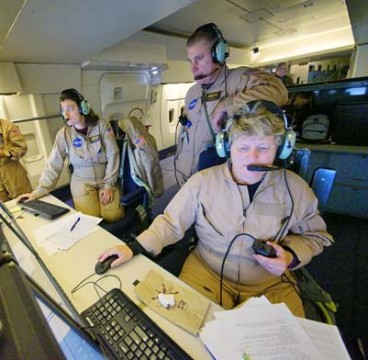
Govert Schilling
We take off from Christchurch uneventfully at 10:09 p.m. local time and start heading toward our target point. The centerline's exact location has been calculated by Amanda Bosh at the Massachusetts Institute of Technology (MIT) in Cambridge, based on astrometry of Pluto carried out that same night by telescopes at Lowell Observatory, the Naval Observatory's Flagstaff Station, and the SARA 24-inch telescope at Cerro Tololo in Chile. But 2 hours after takeoff, Bosh sends a final set of coordinates — the predicted centerline has shifted 225 km farther north than expected. With the plane already heading to the wrong location and the occultation just a few hours away, mission managers scramble to work up a revised flight plan.
Later, instrument scientist Jeffrey Van Cleve tells me that the flight plan actually needed revising a second time. "I checked the shifted central line with the set of MIT coordinates, and they didn't match," he says. "We hadn't taken Earth's curvature into account." Pluto's shadow was indeed 225 km farther north, but because the shadow doesn't hit Earth's surface perpendicularly, the offset was really 332 km. "It's a much bigger correction than we had expected," fretted HIPO scientist Ted Dunham (Lowell Observatory). And there was no time to double-check the new numbers. "We have to trust the new observations," he tells me. "We have no choice."
During the occultation Pluto casts a stellar shadow as wide as its diameter, about 2,300 km (1,430 miles). Observations from anywhere in the path would be scientifically useful, but everyone on board is very keen to hit the shadow path's centerline. When a distant star is exactly behind the center of a planet, a ring of refracted starlight produces a brief brightening in the light curve — a central flash. "We've learned what central-flash observations can tell you about atmospheric hazes," Dunham explains. Little wonder he's worried about whether SOFIA's new path will take his instrument to the right spot.
The computer monitor at the console where I'm seated shows 14th-magnitude Pluto and the occultation star (which is five times brighter) as seen through the telescope's guiding camera. As the hours pass, I can see Pluto closing in on the star at a rate of just under 1 arcsecond every 15 minutes. (Incidentally, this slow-motion merging has little to do with Pluto's inexorably slow orbital motion. Instead, it's almost completely a parallax effect due to Earth's orbital motion around the Sun.)
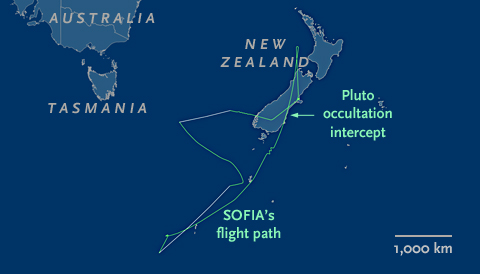
FlightAware.com
Just under 7 hours into the flight, the magic moment finally occurs. We're over the eastern shore of New Zealand's South Island at an altitude of 11.9 km (39,100 feet), flying south-to-north at 986 km per hour; Pluto's shadow is racing across Earth's surface from east to west at almost 90,000 km per hour — a hundred times faster. At 16:53 Universal Time (4:53 a.m. on 30 June New Zealand time), SOFIA intercepts the shadow for just 90 seconds. Everyone around me cheers as they see the star fade, in exact agreement with those last-minute predictions.
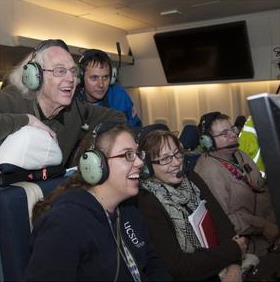
NASA / SOFIA / Carla Thomas
The brightness recording from the guiding camera is available almost instantly, and the star's light curve shows a very pronounced central flash. The plot also shows two very narrow dips: a shallower one some 2 minutes before the start of the occultation and a deeper one about a half minute after the event's end. "I don't think they are real," says Dunham, who's been chasing Pluto's shadow for three decades. "They're probably due to some instrumental effect. On the other hand: they could indicate that Pluto is surrounded by partial rings, just like Neptune." When the FLITECAM data become available, his intuition proves to be correct: the two dips don't show up. If Pluto has a ring system, it must be incredibly thin.
All this scientific drama has added significance, given that NASA's New Horizons spacecraft will fly past Pluto at close range on July 14th. Its ultraviolet imaging spectrometer, called Alice, will record sunlight streaming through Pluto's thin atmosphere as the Sun sets behind the dwarf planet as seen from the spacecraft. Meanwhile, tracking antennas on Earth will measure how New Horizons' radio signal changes as the spacecraft ducks behind Pluto and reappears a short time later.
"The radio occultation samples the lowest parts of the atmosphere, and the UV occultation samples the very highest parts," explains MIT scientist Michael Person, who's the principal investigator for tonight's SOFIA sortie. "Measurements at visible and near-infrared wavelengths fill in the gap. Together, these observations will provide us with a comprehensive view of the structure of Pluto's atmosphere."
"We're very lucky that this occultation of a relatively bright star happens so close to the New Horizons encounter," says Dunham. Pluto's atmosphere has varied over the years, and given that Pluto is moving farther from the Sun in its orbit, there's been concern that those wisps of gas would have frozen completely and collapsed onto the surface by the time New Horizons arrived. Fortunately, Person says, the light curve clearly shows that "the atmosphere is still there."
SOFIA finally touches down at Christchurch International Airport at 6:33 a.m., nearly 8½ hours after it left. I see exhausted but relieved faces all around me. Becklin — a big smile on his face — shakes hands with scientists, telescope operators, mission managers, and flight engineers. Someone collects signatures and farewell messages on a plot of the much-debated flight plan, as a present for telescope operator Karen West, who had just made her last SOFIA flight. It was certainly a memorable one.
 1
1









Comments
Justin S
July 8, 2015 at 7:03 pm
Wow, what an adventure! It's very amazing! I'm thrilled that it went well! Congratulations to all involved!
You must be logged in to post a comment.
You must be logged in to post a comment.